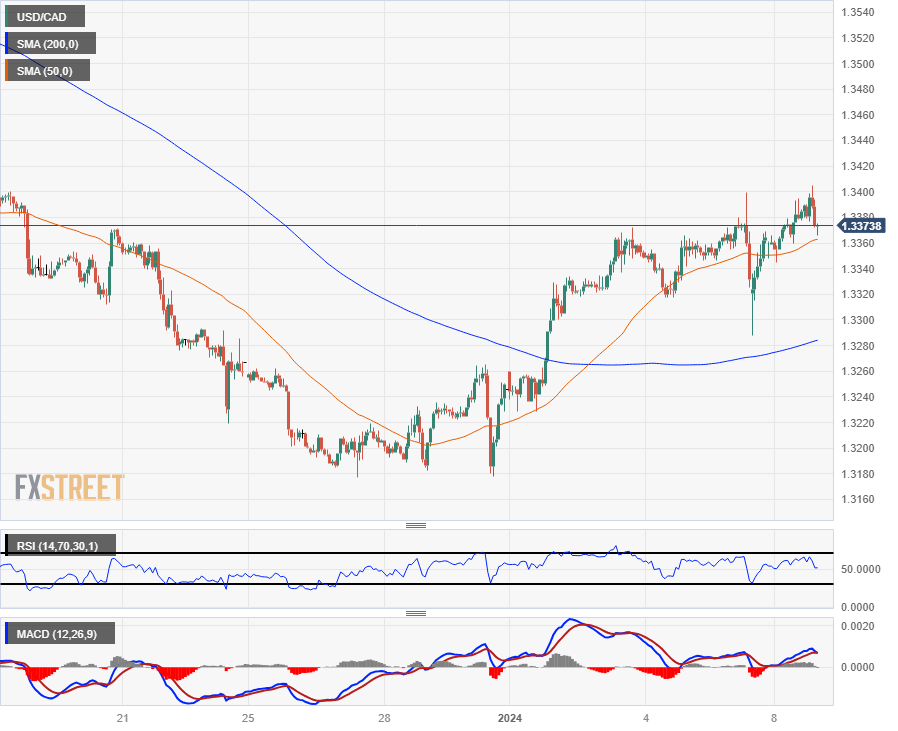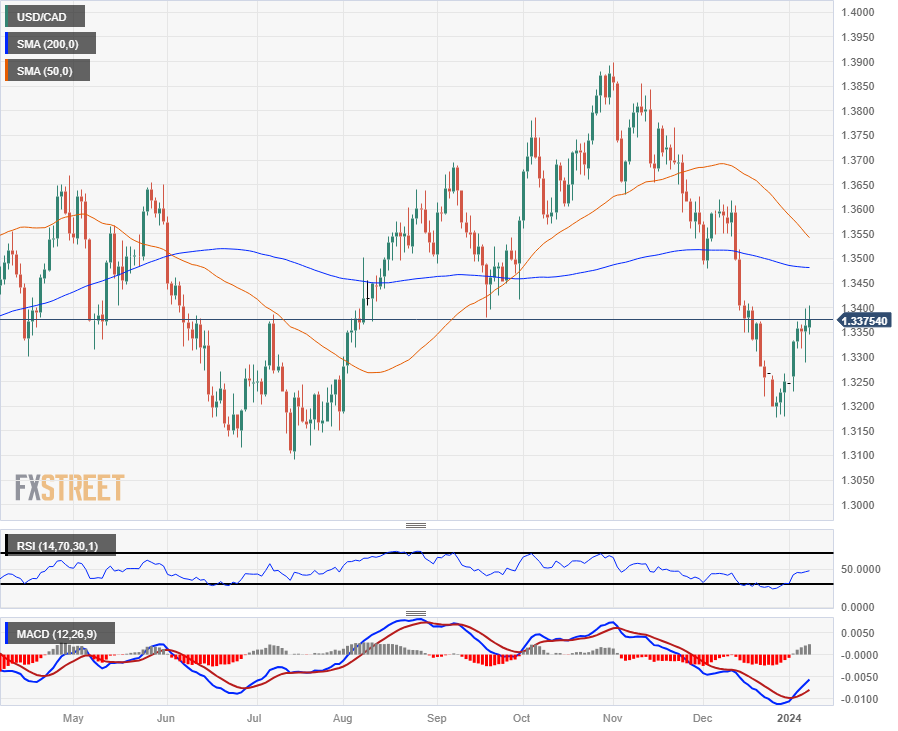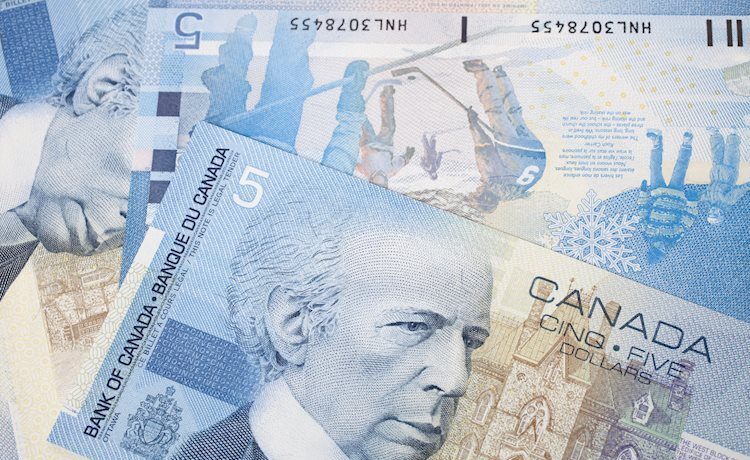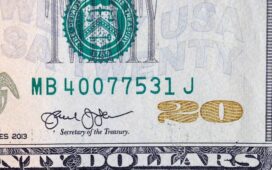- Canadian Dollar broadly turns lower amidst Crude Oil rout.
- Canada economic data docket is thin this week.
- Crude Oil tumbles once again in choppy trading as downside pressure mounts.
The Canadian Dollar (CAD) sees downside pressures across the major currencies board on Monday, getting pushed down the charts by a backsliding Crude Oil market to kick off the second week of 2024.
Canadian International Merchandise Trade Balance and Building Permits, both slated for release on Tuesday, represent the only data showings for the Canadian Dollar on this week’s economic calendar. Markets are still adjusting after last Friday’s US Nonfarm Payrolls (NFP) print saw heavy revisions to previous periods.
Weakening economic figures are the name of the game for data points from Canada, with Tuesday’s Canadian International Merchandise Trade Balance forecast to decline from 2.97 billion to 1.8 billion for November. Meanwhile, Canadian November Building Permits are likewise expected to slip from 2.3% to 2.0%.
Daily digest market movers: Canadian Dollar softens on despondent Crude Oil demand outlook
- Another slump in Crude Oil is dragging down the Canadian Dollar on waffling Middle East barrel prices.
- Saudi Arabia slashed the prices they charge to trading partners in Asia for Saudi crude as production cuts from the Organization of Petroleum Exporting Countries (OPEC) continue to get foiled by slumping barrel demand from key oil market drivers such as China.
- US Crude Oil production continues to pump at or near record levels near 13 million barrels per day.
- The legs continue to get kicked out from underneath broad market expectations of global undersupply that has yet to materialize despite months of production cuts.
- Last Friday’s US NFP goosed market expectations of Fed rate cuts after printing well above expectations, despite a steep downside revision to previous periods’ prints. A firm employment outlook in the US makes it less likely that the Federal Reserve (Fed) will get pushed into a rate cut cycle as soon as investors were initially hoping for.
- Key US data for this week lands on Thursday with another round of the US Consumer Price Index (CPI) inflation print.
- Headline annualized US CPI inflation is expected to tick up slightly from 3.1% to 3.2% for December.
Canadian Dollar price today
The table below shows the percentage change of Canadian Dollar (CAD) against listed major currencies today. Canadian Dollar was the weakest against the Japanese Yen.
| USD | EUR | GBP | CAD | AUD | JPY | NZD | CHF | |
| USD | -0.24% | -0.30% | 0.07% | 0.07% | -0.59% | 0.06% | -0.48% | |
| EUR | 0.25% | -0.04% | 0.32% | 0.31% | -0.32% | 0.31% | -0.24% | |
| GBP | 0.30% | 0.05% | 0.37% | 0.34% | -0.28% | 0.35% | -0.19% | |
| CAD | -0.07% | -0.32% | -0.39% | -0.01% | -0.62% | -0.02% | -0.56% | |
| AUD | -0.06% | -0.31% | -0.37% | 0.00% | -0.61% | -0.01% | -0.55% | |
| JPY | 0.54% | 0.35% | 0.28% | 0.66% | 0.63% | 0.65% | 0.08% | |
| NZD | -0.05% | -0.31% | -0.36% | 0.02% | 0.01% | -0.62% | -0.55% | |
| CHF | 0.48% | 0.23% | 0.19% | 0.56% | 0.56% | -0.09% | 0.55% |
The heat map shows percentage changes of major currencies against each other. The base currency is picked from the left column, while the quote currency is picked from the top row. For example, if you pick the Euro from the left column and move along the horizontal line to the Japanese Yen, the percentage change displayed in the box will represent EUR (base)/JPY (quote).
Technical Analysis: Canadian Dollar slides to 3-week low on soft barrel bids, USD/CAD tests 1.3400
The Canadian Dollar (CAD) saw further downside on Monday, sending the Loonie lower against all of its major currency peers. At the time of writing, the Canadian Dollar is down six-tenths of a percent against the Japanese Yen (JPY), half a percent against the Swiss Franc (CHF), and around a third of a percent against both the Pound Sterling (GBP) and the Euro (EUR).
Canadian Dollar losses against the US Dollar (USD) remain limited on Monday, but they are still in the red as the USD/CAD pair extended to test the 1.3400 handle. The Loonie has shed 1.75% against the Greenback bottom-to-top from late December’s bottom bids near 1.3177.
The US Dollar has closed up or mostly flat against the Canadian Dollar for seven consecutive trading days, and Monday is set to chalk in an eighth consecutive loser for the CAD.
A continued upswing in the USD/CAD is set for a challenge from the near-term technical ceiling from the 200-day Simple Moving Average (SMA) just below the 1.3500 major handle, while a downside run into the 1.3200 region will see the pair testing into five-month lows below 1.3175.
USD/CAD Hourly Chart

USD/CAD Daily Chart

Inflation FAQs
Inflation measures the rise in the price of a representative basket of goods and services. Headline inflation is usually expressed as a percentage change on a month-on-month (MoM) and year-on-year (YoY) basis. Core inflation excludes more volatile elements such as food and fuel which can fluctuate because of geopolitical and seasonal factors. Core inflation is the figure economists focus on and is the level targeted by central banks, which are mandated to keep inflation at a manageable level, usually around 2%.
The Consumer Price Index (CPI) measures the change in prices of a basket of goods and services over a period of time. It is usually expressed as a percentage change on a month-on-month (MoM) and year-on-year (YoY) basis. Core CPI is the figure targeted by central banks as it excludes volatile food and fuel inputs. When Core CPI rises above 2% it usually results in higher interest rates and vice versa when it falls below 2%. Since higher interest rates are positive for a currency, higher inflation usually results in a stronger currency. The opposite is true when inflation falls.
Although it may seem counter-intuitive, high inflation in a country pushes up the value of its currency and vice versa for lower inflation. This is because the central bank will normally raise interest rates to combat the higher inflation, which attract more global capital inflows from investors looking for a lucrative place to park their money.
Formerly, Gold was the asset investors turned to in times of high inflation because it preserved its value, and whilst investors will often still buy Gold for its safe-haven properties in times of extreme market turmoil, this is not the case most of the time. This is because when inflation is high, central banks will put up interest rates to combat it.
Higher interest rates are negative for Gold because they increase the opportunity-cost of holding Gold vis-a-vis an interest-bearing asset or placing the money in a cash deposit account. On the flipside, lower inflation tends to be positive for Gold as it brings interest rates down, making the bright metal a more viable investment alternative.





